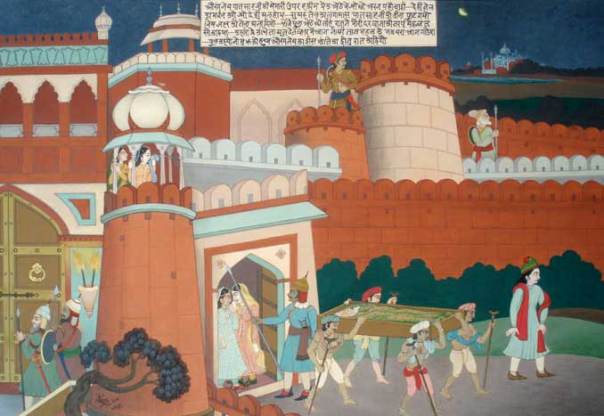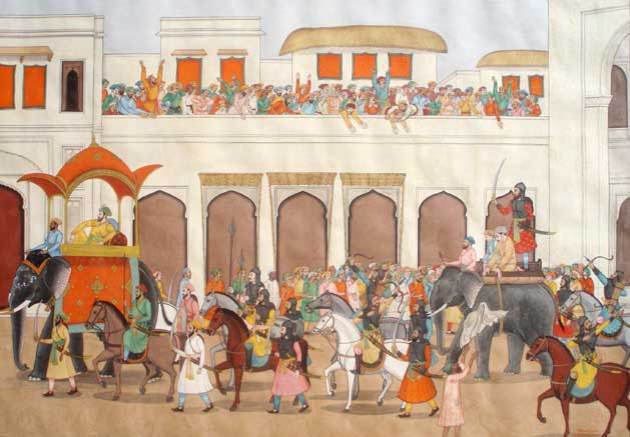ஔரங்கஸேப் யார்?
இஸ்லாமிய அரசு அமைக்க - பெற்ற தந்தையையே கொலை செய்யலாம்
According to Mughal Records, Aurangzeb, Emperor Shah Jahan's sixth son, was born on 24th October 1618 at Dohad in Madhya Pradesh, and wrested India's crown from his father before the end of June 1658, after defeating his brother Prince Dara Shukoh's armies, first at Dharmat near Ujjain (15th April 156 ![]() and the second, led by Dara himself, at Samugarh on 29th May 1658.
and the second, led by Dara himself, at Samugarh on 29th May 1658.
The war of Succession to the richest throne in the world was practically over with this victory, and Aurangzeb secured his position by making Murad, his brother and accomplice in his impetuous pursuit for power, his prisoner, by treachery, on 25th June. He had already made his old father Emperor Shah Jahan a prisoner in the Agra Fort (8th June 1658).
Shah Jahan survived his confinement by nearly eight years and the disgraceful manner of his burial (Exhibit No.5) will ever remain a stigma on this unscrupulous son Aurangzeb's advent to the throne in his father's life time was not welcomed by the people of India, because of the treacherous manner it was achieved.
இஸ்லாமிய அரசு அமைக்க சொந்த சகோதரனைத் தோலை உரித்து கொல்லலாம்
The public opinion became all the more hostile towards Aurangazeb when Prince Dara Shukoh, the favourite son of Shah Jahan, the translator of the Upanishads (Exhibit No.2), and a truly liberal and enlightened Musalman, was taken prisoner on the Indian border, as he was going to Persia. Dara was paraded in a most undignified manner on the streets of Delhi on 29th August 1659.
The French Doctor, Bernier, was an eye-witness to the scene and was deeply moved by the popular sympathy for Dara (Exhibit No.3) which so much alarmed Aurangzeb that he contrived to have a decree from his Clerics announcing death-sentence for his elder brother on the charge of apostasy (Exhibit No.4).
Throughout the War of Succession, Aurangzeb had maintained that he was not interested in acquiring the throne and that his only object was to ward off the threat to Islam, which was inevitable in case Dara Shukoh came to power. Many, including his brother Murad, were deceived by this posture. After his formal accession in Delhi (5th June 1659) he posed as a defender of Islam who would rule according to the directions of the Shariat, and with the advice of the Clerics or Ulama for whom the doctrines, rules, principles and directives, as laid down and interpreted in the 7th and 8th century Arabia, Persia and Iraq, were inviolable and unchangeable in all conditions, in all countries,and for all times to come.
பிற மதத் தெய்வங்களை செருப்பால் மிதிக்கத் தூண்டும் இஸ்லாம்
One of the main objectives of Aurangzeb's policy was to demolish Hindu temples. When he ordered (13th October 1666) removal of the carved railing, which Prince Dara Shukoh had presented to Keshava Rai temple at Mathura, he had observed "In the religion of the Musalmans it is improper even to look at a temple", and that it was totally unbecoming of a Muslim to act like Dara Shukoh (Exhibit No.6, Akhbarat, 13th October 1666).
This was followed by destruction of the famous Kalka temple in Delhi (Exhibit No.6, 7, 8, Akhbarat, 3rd and 12th September 1667).
In 1669, shortly after the death of Mirza Raja Jai Singh of Amber, a general order was issued (9th April 1669) for the demolition of temples and established schools of the Hindus throughout the empire and banning public worship (Exhibit Nos.9 & 10). Soon after this the great temple of Keshava Rai was destroyed (Jan.-Feb. 1670) (Exhibit No.12) and in its place a lofty mosque was erected. The idols, the author of Maasir-i-Alamgiri informs, were carried to Agra and buried under the steps of the mosque built by Begum Sahiba in order to be continually trodden upon, and the name of Mathura was changed to Islamabad. The painting (Exhibit No.13) is thus no fancy imagination of the artist but depicts what actually took place.
சொக்கவைக்கும் சோமநாதபுரக் கோயிலை சூறையாடத் தூண்டிய இஸ்லாம்
This was followed by Aurangzeb's order to demolish the highly venerated temple of Vishwanath at Banaras (Persian text, Exhibit No.11),Keshava Rai temple (Jan.-Feb. 1670) (Persian Text, exhibit No.12 and Painting, Exhibit No.13), and of Somanatha (Exhibit No.14).
To save the idol of Shri Nathji from being desecrated, the Gosain carried it to Rajputana, where Maharana Raj Singh received it formally at Sihad village, assuring the priest that Aurangzeb would have to trample over the bodies of one lakh of his brave Rajputs, before he could even touch the idol (Exhibit No.15) .
Aurangzeb's zeal for temple destruction became much more intense during war conditions. The opportunity to earn religious merit by demolishing hundreds of temples soon came to him in 1679 when, after the death of Maharaja Jaswant Singh of Jodhpur in the Kabul Subah, he tried to eliminate the Rathors of Marwar as a political power in Rajputana. But Maharana Raj Singh of Mewar, in line with the great traditions of his House, came out in open support of the Rathors.
This led to war with both Mewar and Marwar during which the temples built on the bank of Rana's lake were destroyed by his orders (Exhibit No.23, Akhbarat 23rd December 1679) and also about three hundred other temples in the environs of Udaipur. (Exhibit No.25, Text), including the famous Jagannath Rai temple built at a great cost in front of the Maharana's palace which was bravely defended by a handful of Rajputs (Exhibit Nos.20, 21). Not only this, when Aurangzeb visited Chittor to have a view of the famous fort, he ordered the demolition of 63 temples there which included some of the finest temples of Kumbha's time (Exhibit No.22).
From Marwar (in Western Rajasthan) alone were brought several cart-loads of idols which, as per Aurangzeb's orders, were cast in the yard of the Court and under the steps of Jama Masjid (Exhibit No.19). Such uncivilized and arrogant conduct of the Mughal Emperor alienated Hindus for ever, though they continued to be tolerant towards his creed. In June 1681, orders, in a laconic two-liner, were given for the demolition of the highly venerated Jagannath Temple in Orissa (Exhibit No.24, Akhbarat, 1st June 1681).,
Shortly afterwards, in September 1682, the famous Bindu-Madhav temple in Banaras was also demolished as per the Emperor's orders (Exhibit No.27, Akhbarat, Julus 26, Ramzan 20). On 1st September 1681, while proceeding to the Deccan, where his rebel son Prince Akbar, escorted by Durga Das Rathore, had joined Chhatrapati Shivaji's son, Shambhaji, thus creating a serious problem for him, Aurangzeb ordered that all the temples on the way should be destroyed. It was a comprehensive order not distinguishing between old and newly built temples (Exhibit No.26, Akhbarat, Julus 25, Ramzan 18). But in the district of Burhanpur, where there were a large number of temples with their doors closed, he preferred to keep them as such, as the Muslims were too few in number in the district. (Exhibit No.28, Akhbarat 13th October 1681).
In his religious frenzy, even temples of the loyal and friendly Amber state were not spared, such as the famous temple of Jagdish at Goner near Amber (Exhibit Nos.30, Akhbarat, 28th March and 14th May 1680). In fact, his misguided ardour for temple destruction did not abate almost up to the end of his life, for as late as 1st January 1705 we find him ordering that the temple of Pandharpur be demolished and the butchers of the camp be sent to slaughter cows in the temple precincts (Akhbarat 49-7). The number of such ruthless acts of Aurangzeb make a long list but here only a few have been mentioned, supported by evidence, mostly contemporary official records of Aurangzeb's period and by such credible Persian sources as Maasir-i-Alamgiri.
ஹிந்துக்களை ஏழைகளாக்க வரிகளின் வடிவில் கொள்ளையடிக்கத் தூண்டும் இஸ்லாம்
In obedience to the Quranic injunction, Aurangazeb reimposed Jizyah on the Hindus on 2nd April 1679 (Exhibit No.16), which had been abolished by Emperor Akbar in 1564, causing widespread anger and resentment among the Hindus of the country.
A massive peaceful demonstration against this tax in Delhi, was ruthlessly crushed (Exhibit No.17), This hated tax involved heavy economic burden on the vast number of the poor Hindus and caused humiliation to each and every Hindu (Exhibit No.18).
In the same vein, were his discriminatory measures against Hindus in the form of exemption of the Muslims from the taxes (Exhibit No.31, Akhbarat 16th April 1667) ban on atishbazi and restriction on Diwali (Exhibit No.32), replacement of Hindu officials by Muslims so that the Emperor's prayers for the welfare of Muslims and glory of Islam, which were proving ineffective, be answered (Exhibit Nos.33, 34). He also imposed a ban on ziyarat and gathering of the Hindus at religious shrines, such as of Shitla Mata and folk Gods like Pir Pabu (Exhibit No.35, Akhbarat 16th September 1667), another ban on their traveling in Palkis, or riding elephants and Arab-Iraqi horses, as Hindus should not carry themselves with the same dignity as the Muslims! (Exhibit No.36).
In the same vein came brazen attempts to convert Hindus by inducement, coercion (Exhibit No.41) or by offering Qanungoship (Exhibit No.44, 45, 46) and to honour the converts in the open Court. His personal directions were that a Hindu male be given Rs.4 and a Hindu female Rs.2 on conversion (Exhibit No.43,Akhbarat 7th April 1685). "Go on giving them", Aurangzeb had ordered when it was reported to him that the Faujdar of Bithur, Shaikh Abdul Momin, had converted 150 Hindus and had given them naqd (cash) and saropas (dresses of honour) (Exhibit No.40, Akhbarat, 11th April 1667). Such display of Islamic orthodoxy by the State under Aurangzeb gave strength and purpose to the resistance movements such as of the Marathas, the Jats, the Bundelas and the Sikhs (Exhibit No.46).
வீர வேதாந்தி சிவாஜியின் முன் வெறுப்பு பரப்பும் இஸ்லாத்தின் வேந்தனும் துரும்பு
On the 12th May 1666, the dignity with which Shivaji carried himself in the Mughal court and defied the Emperor's authority, won him spontaneous admiration of the masses. Parkaldas, an official of Amber (Jaipur State) wrote in his letter dated 29th May 1666, to his Diwan. "Now that after coming to the Emperor's presence Shivaji has shown such audacity and returned harsh and strong replies, the public extols him for his bravery all the more …" (Exhibit No.37). When Shivaji passed away on April 1680 at the age of 53 only, he had already carved a sufficiently large kingdom, his Swarajya, both along the western coast and some important areas in the east as well.
Aurangzeb could never pardon himself for his negligence in letting Shivaji escape from his well laid trap and wrote in his Will (Exhibit No.4 ![]() that it made him "to labour hard (against the Marathas) to the end of my life (as a result of it)". He did not realize that it was his own doing: the extremely cruel manner – even for those times - in which he put to death Shivaji's son, Shambhaji (Exhibit No.3
that it made him "to labour hard (against the Marathas) to the end of my life (as a result of it)". He did not realize that it was his own doing: the extremely cruel manner – even for those times - in which he put to death Shivaji's son, Shambhaji (Exhibit No.3 ![]() made the Maratha king a martyr in the eyes of the masses and with that commenced the People's War in Maharashtra and the Deccan which dug the grave of the Mughal empire.
made the Maratha king a martyr in the eyes of the masses and with that commenced the People's War in Maharashtra and the Deccan which dug the grave of the Mughal empire.
Till the very end Aurangzeb never understood that the main pillars of the government are the affection and support of the people and not mere compliance of the religious directives originating from a foreign land in the seventh-eighth centuries. His death after a long and ruinous reign lasting half a century, ended an eventful epoch in the history of India. He left behind a crumbling empire, a corrupt and inefficient administration, a demoralized army, a discredited government facing public bankruptcy and alienated subjects.










No comments:
Post a Comment